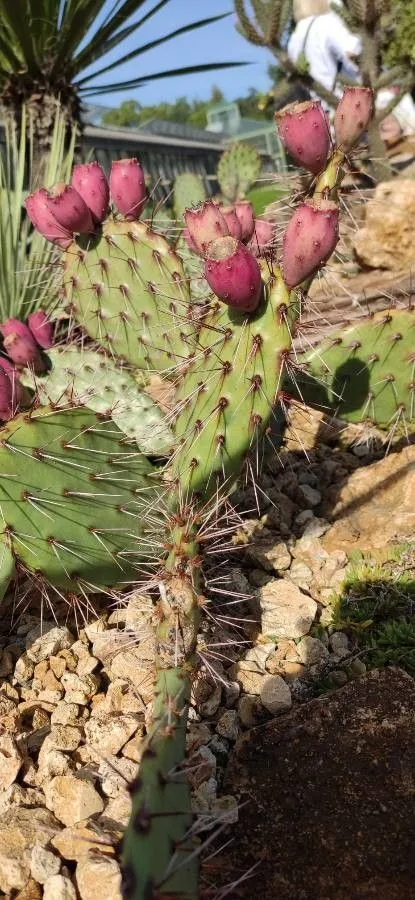
Author: Engelm.
Bibliography: Mem. Amer. Acad. Arts ser. 2, 4:52. 1849 (Pl. fendler.)
Year: 1849
Status: accepted
Rank: species
Genus: Opuntia
Vegetable: False
Observations: C. & SW. U.S.A. to N. Mexico
The New Mexico prickly-pear is a notable member of the diverse cactus family, scientifically known as Opuntia phaeacantha. This species was first described in the mid-19th century by Engelmann in the journal Mem. Amer. Acad. Arts. Renowned for its hardy nature and distinctive appearance, the New Mexico prickly-pear thrives predominantly in the central and southwestern regions of the United States, extending its range into northern Mexico.
Belonging to the Cactaceae family, Opuntia phaeacantha features classic prickly-pear characteristics such as fleshy, cladode-like segments that serve as photosynthetic organs. These segments, often referred to as pads, are typically covered in small, sharp spines known as glochids, which can easily detach and embed in the skin upon contact. The plant’s resilience in arid environments is a testament to its ability to conserve water and withstand high temperatures, while its deep roots allow it to access subsurface moisture.
Although its common name hints at its geographic affiliation, the New Mexico prickly-pear holds significant ecological importance across its range. It provides shelter and sustenance for a variety of wildlife, including birds and small mammals, which feed on its vibrant, sometimes edible fruits. The flowers, which bloom in warm seasons, showcase stunning hues ranging from yellow to deep orange, contributing to the local biodiversity and serving as a food source for pollinators like bees and butterflies.
In cultivation, this Opuntia species is highly favored for xeriscaping due to its low water requirements and minimal maintenance needs. Its adaptability and striking appearance make it an attractive addition to gardens and landscapes designed to emulate natural desert environments.
In summary, the New Mexico prickly-pear, Opuntia phaeacantha, is a remarkable cactus that embodies the tenacity and beauty of desert flora. Its presence across a vast range of habitats underscores its ecological value and enduring appeal in the American Southwest and beyond.
Eng: mojave prickly-pear, new mexico prickly-pear, brown-spine prickly-pear, dense-spine prickly-pear, desert prickly-pear, major prickly-pear, purple-fruit prickly-pear, yellow-spine prickly-pear, brownspine pricklypear, tulip pricklypear
Spa: nopal pardo, cholla, chumbera, tuna
Swe: blåopuntia
Fra: figuier de barbarie à fruits violets
Ces: opuncie hnědoostná
En: New Mexico prickly-pear, Desert prickly-pear, Major prickly-pear, Dense-spine prickly-pear, Mojave prickly-pear, Purple-fruit prickly-pear, Yellow-spine prickly-pear, Brown-spine prickly-pear, BROWNSPINE PRICKLYPEAR, Tulip pricklypear
Cs: Opuncie hnědoostná
Fr: Figuier de Barbarie à fruits violets, Oponce
Es: Nopal pardo, Cholla, Chumbera, Tuna
Sv: Blåopuntia
Taken Aug 21, 2021 by pauline leprovost (cc-by-sa)
Taken Sep 19, 2021 by English with Vlad (cc-by-sa)
Taken Sep 8, 2021 by Dieter Albrecht (cc-by-sa)
Taken Feb 13, 2022 by Thomas Alberti (cc-by-sa)
Taken Sep 25, 2021 by Francois Mathieu (cc-by-sa)
Taken Jun 20, 2020 by Quinn Jacobs (cc-by-sa)
Taken Oct 23, 2020 by Fabrizio Giunta (cc-by-sa)
Taken Jul 4, 2022 by Hana Bendova (cc-by-sa)
Taken Jun 30, 2020 by Franco Jorge (cc-by-sa)
Taken Oct 25, 2021 by Dagmara Bernecka (cc-by-sa)
Taken Jul 1, 2014 by EOL − Carlos Velazco (cc-by-nc)
Taken Jul 8, 2015 by EOL − Juan Carlos Ibarra Flores (cc-by-sa)
Taken Jun 9, 2010 by EOL − Gerald and Buff Corsi (cc-by-nc-sa)
Taken Jun 9, 2010 by EOL − Robert Sivinski (cc-by-nc)
Taken Sep 8, 2021 by Dieter Albrecht (cc-by-sa)
Taken Jul 1, 1992 by Daniel Barthelemy (cc-by-nc)
Taken Aug 15, 2019 by Francisco Sabino (cc-by-sa)
Taken Nov 1, 2012 by EOL − Justin (cc-by-nc-sa)
Taken Nov 22, 2018 by Salvor Hardin (cc-by-sa)
Taken May 22, 2021 by Danielle Bludworth (cc-by-sa)
Taken Mar 29, 2018 by mlabattut (cc-by-sa)
Taken Jul 7, 2021 by Esteban Teresa (cc-by-sa)
Taken Jun 10, 2020 by nata.kaktus (cc-by-sa)
Taken May 22, 2022 by Monique Vernet (cc-by-sa)
Growth habit>: Shrub
Family: Myrtaceae Author: (F.Muell.) K.D.Hill & L.A.S.Johnson Bibliography: Telopea 6: 402 (1995) Year: 1995 Status:…
Family: Rubiaceae Author: Pierre ex A.Froehner Bibliography: Notizbl. Bot. Gart. Berlin-Dahlem 1: 237 (1897) Year:…
Family: Sapindaceae Author: Koidz. Bibliography: J. Coll. Sci. Imp. Univ. Tokyo 32(1): 38 (1911) Year:…
Family: Asteraceae Author: A.Gray Bibliography: Pacif. Railr. Rep.: 107 (1857) Year: 1857 Status: accepted Rank:…
Family: Fabaceae Author: Medik. Bibliography: Vorles. Churpfälz. Phys.-Ökon. Ges. 2: 398 (1787) Year: 1787 Status:…
Family: Aspleniaceae Author: (Cav.) Alston Bibliography: Bull. Misc. Inform. Kew 1932: 309 (1932) Year: 1932…